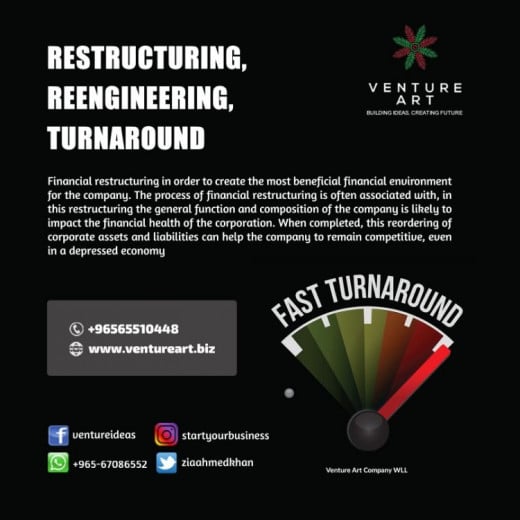Due Diligence of Distress Assets
Restructuring to Success
In the present financial crisis the first and very question is can we save the financial system? There is only one answer and that is yes, we have to any how? If we start for how can we have, what are the measures can be taken.
Where is problem?
- Very simple answer is mismatch of assets and liabilities.
- Liquidity is the second issue, want of immediate cash to fulfill ongoing operations.
What we have on balance sheet?
We can divide assets into four categories.
- Securities and liquid assets.
- Real Estate
- Investment in Subsidiaries and Associates ( operating companies)
- Other Investment – non defined investment.
Liabilities
- Short Term
- Long Term
- Project Finance
- Other
Restructuring, re-engineering and Turnaround of Investment Companies to save the Financial System
· Restructuring
o Financial Restructuring
o Organizational Restructuring
General term for major corporate changes aimed at greater efficiency and adaptation to changing markets. Spin-Offs, Recapitalizations, Strategic Buyouts and major management realignments are all developments frequently associated with corporate restructurings.
Restructuring is the corporate management term for the act of partially dismantling or otherwise reorganizing a company for the purpose of making it more efficient and therefore more profitable.
A significant modification made to the debt, operations or structure of a company. This type of corporate action is usually made when there are significant problems in a company, which are causing some form of financial harm and putting the overall business in jeopardy. The hope is that through restructuring, a company can eliminate financial harm and improve the business.
Organizational Restructuring
Organizations are human systems and their system structure includes the worldview, beliefs, and mental models of their leaders and members. Changing organizational behavior requires changing the belief system of its personnel. This process of changing beliefs is called learning. Effective learning requires clear, open communications throughout the organization.
Organizational performance ultimately rests on human behavior and improving performance requires changing behavior. Therefore organizational restructuring should have as a fundamental goal the facilitation of clear, open communication that can enable organizational learning and clarify accountability for results.
Since the world is continually changing, continuous organizational learning is necessary to stay up to date. Organizations that cannot or will not learn will become obsolete. Leaders should periodically examine the organizational structure of their enterprise to assure that it continues to provide an environment for organizational learning. A non threatening, development focused performance appraisal process can be an effective organizational learning tool.
The points of leverage in organizations are the beliefs and worldview of their leaders and decision makers. The sense of purpose, vision and commitment of an organization's leadership play a critical role in the results it can accomplish.
Restructuring for Securities and Other Liquid Assets
Government should form a trust that will take over all these assets based on defined value and provide liquidity to the companies for operations. These assets will be kept there for long term, and companies will get a share of profit from this. There will 3 to 5 years plan, depending upon companies they can keep or sell the assets, the profits will be shared with trust that provided liquidity against these securities.
This method is successfully used by Indian Government when market fell by 50% in 2001.In this situation which is USD 20 billion plan government of India has got very good profits. This has taken 3 to 5 years for the trust to get everything cleaned. (US 64 and Restructuring of UTI)
The Second Class of Assets is Real Estate _ Develop land Bank Trust
At this points government should divide the country and declare the zone wise base rate for the land and buildings. This will provide benefits to real estate companies and bring the normalcy in the market. Government should form a trust to complete the ongoing project and fund and support the companies who want immediate cash or liquidity for operations against these lands.
There should be large scale development for expatriate’s bachelors in the exclusive areas. Speculation should stop and to stop speculation government should think of capital gains tax.( Short sell and speculation should not be allowed.)
Foreign ownership of the properties should be allowed. Allow expatriates working in Kuwait to own properties here.
Government should form a trust for those properties which distress companies want to sell, such properties should be bought at predetermined prices and in the course of time two to five years when crises was over trust can auction these properties, the original owner should get part of this profit. This will stabilize market in long run and make it work for companies.
Long term development plan – Government should declare long term development plan, and should finance such companies to develop such housing project and buy it at predetermined prices. This will help such companies in getting over the crises.
Investment in Subsidiary and Associates and Operating Companies
Benchmarking of existing companies against the global standards is must. Each company must study its profitability against the existing global norm.
Value of the portfolio – Are these companies has any synergy and value together or not. Strategy to create value is very important. Value can be created by Integration (Vertical and Horizontal).
Under present circumstances odd companies or the companies which does not fit into strategy should be divested or spin off to work independently.
Divestment and Spin Off
Often the term is used as a means to grow financially in which a company sells off a business unit in order to focus their resources on a market it judges to be more profitable, or promising. Sometimes, such an action can be a spin-off. (For the United States); A company can divest assets to wholly owned subsidiaries.
The creation of an independent company through the sale or distribution of new shares of existing business/division of a parent company. A spin-off is a type of divestiture. Businesses wishing to 'streamline' their operations often sell less productive or unrelated subsidiary businesses as spin-offs. The spun-off companies are expected to be worth more as independent entities than as parts of a larger business.
These companies can sold to local healthy companies, this will create value and get required cash to the companies.
Other Assets
These are the assets the companies have not defined on the balance sheet. Based on the type and location of the assets they should be studied and any decision required to be taken – the class of assets, the location and strength of the assets. All such assets can be given to asset reconstruction companies.
Liabilities
The bank and company should come to the solution on ling term and short term liabilities the company has.
· Converting part of the liability to equity.
· Re-scheduling of the loan repayment.
· Capitalization of interest at lower rate.
· Say of the bank in restructuring proposal like the bankruptcy courts.
Why Asset Reconstruction Companies?
Asset Reconstruction Companies have been set up in various countries internationally as an answer to the global problem of bad loans.
Bad loans are essentially of two types: bad loans generated out of the usual banking operations or bad lending, and bad loans which emanate out of a systematic banking crisis.
It is in the latter case that Banking Regulators or Governments try to bail out the banking system of a systematic accumulation of bad loans which acts as a drag on their liquidity, balance sheets and generally the health of banking. So, the idea of ARCs is not to protect banks, but to provide an umbrella to the Banking system itself.
There are essentially two approaches for taking care of these systematic bail out efforts: one, leave the banks to manage their own bad loans by giving them incentives, legislative powers, or special accounting or fiscal advantages. The second approach is to do the same thing on a concerted, central level, through a centralised agency or agencies.
What are the advantages of an ARC approach
- Centralization of bad loans in one or a few hands and therefore obviously more effective
- It is possible to give special legislative powers to ARCs rather than to each bank
- Banks are left with cleaner balance sheets and do not have to deal with problem clients. Regular banking relations with the group are not affected.
- Because it deals with a larger portfolio, it can mix up good assets with bad ones and make a sale, which is acceptable to buyers.
- It is easier to have a capital-market based funding for an ARC than for the Banks themselves.
Asset reconstruction business constitutes essentially in unlocking the values embedded in the NPAs and sharing these in an equitable manner with various stakeholders. Theoretically, this is tailor-made for the common weal of all the concerned players and by now the market should have been abuzz with frenetic action on this front. If this not happened on the scale anticipated, the reasons can be the following.
* The concept is relatively new and its philosophy and practice have not seeped firmly in the minds of the players, especially the lenders. With the fear of the unknown stalking their minds, they are understandably wary of taking the kind of plunge that is necessary for giving a discernable fillip to this business.
* The more daunting issue to grapple with is the emotional mooring NPAs provide to the employees of the lenders presently engaged in husbanding these impaired assets. This is more pronounced among public sector outfits, accounting for a lion’s share in this business, and not subject to the kind of tough business targets of asset resolution as are mandated by their foreign and private sector counterparts.
Typically they draw their sense of worth for the organization from continued association with these assets and separating them from these NPAs is huge challenge. More often than not they put up road blocks in the transfer of the assets as viable resolution strategy. Creating an alternative niche for them in the organization before dislodging from this entrenched vestige of self-esteem is the only option for these lenders.
* Another connected issue relates to price discovery. The lenders tend to exaggerate the realizable value trapped in the assets mostly as a result of irrational exuberance, and sometimes on the basis of their limited experience of netting good value in a small number of cases. They are oblivious of the difficulty in replicating such experience on a sustainable basis for a larger pool of assets. Sometimes they are guided by the success of the ARCs in realizing a handsome price for transferred assets.
They need to realize that these cases are few and far between, and could be the outcome of ARC’s power of debt agglomeration and aggressive resolution strategies. This domain strength is not the specialization of a commercial lender. The inevitable outcome of this level of expectation, not getting a matching response from ARCs is that these assets continue to clog the lender’s balance sheet and degenerate with passage of time triggering further value erosion.
The concerns relating to Price discovery issue can be best addressed through a transparent system of competitive bidding. The lender can also stay invested in the assets transferred to ARCs to benefit from the upsides of resolution of such assets, if any. But expecting to get the whole transfer price upfront on the basis of estimated value way out of the market realities is unlikely to happen.
In the light of forgoing the time is now ripe for the lending community to look upon ARCs as a potent tool resolving their NPA problem. The compelling reasons are there for everyone to see;
* This is specialized activity needing fleet footed, focused strategy and approach, multi disciplinary skill and a completely different mindset and orientation, which can not be domiciled within a commercial lending perimeter. Spinning off these assets from their books would release a lot of physical, financial and human capital, paving the way for their deployment in the core business besides substantial savings on maintenance of theses assets in their books.
Restructuring




Understanding Valuation
- Art of Managing Balance Sheet
Art of Managing Balance Sheet IFRS is considered as one of the greatest innovation in modern accounting, developed by the accountant themselves and also promoted and ranked as best themselves. I am just giving few insights into how companies are... - What is Value Creation in Acquisition
How to Create Value in Acquisition 1. Introduction Invest Turnaround and Harvest Private Equity will invest in existing companies that, in the eyes of investors, are underperforming and new green field,... - How to Restructure and Turnaround a Company
The Road Ahead- Strategy – Plan for Value Creation 1. Introduction At first, the work of the INVESTMENT ISLAMIC is to begin building the fund’s portfolio consistent with its investment objectives. While investing... - Listed Real Estate Companies of India Analysis
India’s Listed Real Estate Companies Performance Analysis Dream gone If we look at performance of India’s BSE Realty Index and companies listed in it, it has wiped out investors’ money; there must be someone who has made money. I have... - Due Diligence and Valuation of Distress Assets
Due Diligence is very important to the success of any Acquisition process. Specially it become more important when the assets is distress. The valuation is rea…






